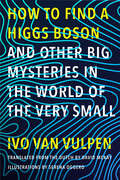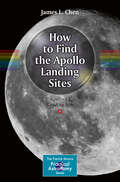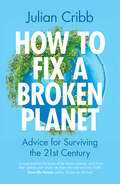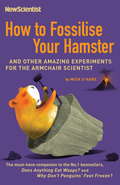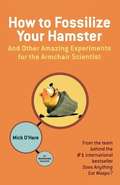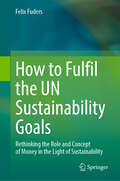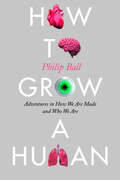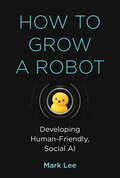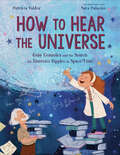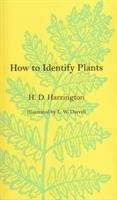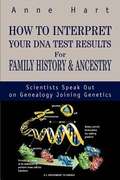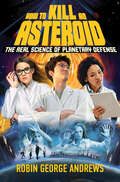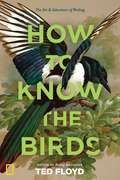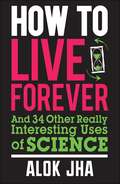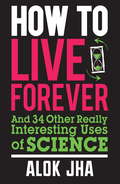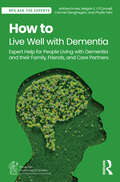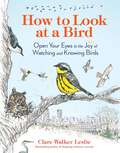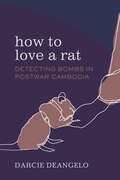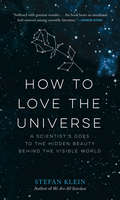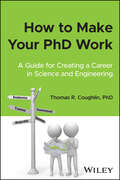- Table View
- List View
How to Find a Higgs Boson—and Other Big Mysteries in the World of the Very Small
by Ivo van VulpenThe history of particle physics, the hunt for the most elusive particle, and the fundamental questions the search has inspired How did physicists combine talent and technology to discover the Higgs boson, the last piece in our inventory of the subatomic world? How did the Higgs change our understanding of the universe? And now, nearly a decade after its detection, what comes next? Answering these questions, Ivo van Vulpen—a CERN particle physicist and member of the team behind the detection—invites us on a journey to the frontiers of our knowledge. Enjoy van Vulpen&’s accessible explanation of the history of particle physics and of concepts like quantum mechanics and relativity—and ponder his inquiries regarding the search for new particles (to explain dark matter), a new force (to combine the existing fundamental forces), and new phenomena (undiscovered dimensions of space). This is a lively account of work at the world&’s highest-energy particle accelerator, with inspiring personal reflections on humanity&’s discoveries deeper and deeper into the world of the very small.
How to Find the Apollo Landing Sites
by James L. ChenThis book is for anyone who wants to be able to connect the history of lunar exploration to the Moon visible above. It addresses what Apollo equipment and experiments were left behind and what the Apollo landings sites look like now. Each Apollo mission is examined in detail, with photos that progressively zoom-in to guide the reader in locating the Apollo landing sites. Guided by official NASA photographs from the Lunar Reconnaissance Orbiter and the original Apollo missions, the reader can view the Moon with a new appreciation of the accomplishment of landing astronauts on its surface. Countless people have gazed at the Moon in the night sky knowing the successes of the Apollo Program in landing men on the Moon. After the information in this guide, casual and serious observers can actually point out where the Apollo landings occurred as well as knowing why those sites were chosen.
How to Fix a Broken Planet: Advice for Surviving the 21st Century
by Julian CribbDo you want to help save human civilisation? If so, this book is for you. How to Fix a Broken Planet describes the ten catastrophic risks that menace human civilisation and our planet, and what we can all do to overcome or mitigate them. It explains what must be done globally to avert each megathreat, and what each of us can do in our own lives to help preserve a habitable world. It offers the first truly integrated world plan-of-action for a more sustainable human society - and fresh hope. A must-read for anyone seeking sound practical advice on what citizens, governments, companies, and community groups can do to safeguard our future.
How to Fossilise Your Hamster: And other amazing experiments for the armchair scientist
by New ScientistHow can you measure the speed of light with chocolate and a microwave? Why do yo-yos yo-yo? Why does urine smell so peculiar after eating asparagus (includes helpful recipe)? How long does it take to digest different types of food? What is going on when you drop mentos in to cola? 100 wonderful, intriguing and entertaining scientific experiments which show scientific principles first hand - this is science at its most popular.
How to Fossilise Your Hamster: And other amazing experiments for the armchair scientist
by New ScientistHow can you measure the speed of light with chocolate and a microwave? Why do yo-yos yo-yo? Why does urine smell so peculiar after eating asparagus (includes helpful recipe)? How long does it take to digest different types of food? What is going on when you drop mentos in to cola? 100 wonderful, intriguing and entertaining scientific experiments which show scientific principles first hand - this is science at its most popular.
How to Fossilize Your Hamster
by Mick O'HareExplaining everything from the extraordinary reaction between Mentos and cola that sets off a geyser to the geological conditions necessary to preserve a family pet for eternity, Mick O'Hare of the New Scientist and his team present dozens of mind-opening experiments that display scientific principles in action: Extract the iron from your breakfast cereal, Measure the speed of light with a chocolate bar and a microwave oven, Investigate the essential physics for getting ketchup out of a bottle, Create an electrical field with a comb, Discover the secret of a martini that's shaken, not stirred, Figure out how much your head weighs (without losing it!). Book jacket.
How to Fulfil the UN Sustainability Goals: Rethinking the Role and Concept of Money in the Light of Sustainability
by Felix FudersThis book combines the field of economics —especially monetary theory— with other disciplines like ecology, physics, humanities, social sciences and development theory. This transdisciplinary approach makes the book a unique contribution for researchers, students, policy makers and professionals working in governmental or nongovernmental institutions, as well as anyone interested in society’s well-being and achieving a true social-ecological transformation. It is written in an accessible language in order to reach a broad audience. In 2015, more than 190 world leaders recognized that the world is on a “collision course” (Max-Neef) and committed to 17 Sustainable Development Goals (SDGs). Many conferences and high-level meetings have been held since then, and one of the most frequently discussed topics is how to finance these goals. There is a widespread belief that coming up with more money for sustainable development will “do the trick”. Usually, the discussions focus on finding additional financial resources in order to achieve the goals faster. In this book it is argued that not only is more money needed, but it needs to be a different kind of money. The book demonstrates that ALL but one of the SDGs are directly linked to our monetary system, which —being completely unnatural— can be seen as the most important, but at the same time least recognized, reason for market failure. Many people think we just need to do more, faster, better. Very few say that we have done things fundamentally wrong and that the institutions and values which motivated us to do those things need to be changed. It will be concluded that only if we change our unnatural design of money to a more natural one, will we be able to reach these goals
How to Grow a Human: Adventures in How We Are Made and Who We Are
by Philip BallThe award-winning science writer shares “a winding romp through advances in cell biology [that] pushes readers to ponder the boundaries of life” (Science).In the summer of 2017, scientists removed a tiny piece of flesh from Philip Ball’s arm and turned it into a rudimentary “mini-brain.” The skin cells, removed from his body, did not die but were instead transformed into nerve cells that independently arranged themselves into a dense network and communicated with each other, exchanging the raw signals of thought. This was life—but whose? That disconcerting question is the focus of Philip Ball’s How to Grow a Human.In this mind-bending tour of cutting-edge cell biology, Ball shows how recent innovations could lead to tailor-made replacement organs; new medical advances for repairing damage and assisting conception; and new ways of “growing a human.” Such methods would also create new options for gene editing, with all the attendant moral dilemmas. Ball argues that these advances can never be “just about the science,” because they are already laden with a host of social narratives, preconceptions, and prejudices. But beyond even that, these developments raise provocative questions about identity and self, birth and death, and force us to ask how mutable the human body really is—and what forms it might take in years to come.
How to Grow a Robot: Developing Human-Friendly, Social AI
by Mark H. LeeHow to develop robots that will be more like humans and less like computers, more social than machine-like, and more playful and less programmed.Most robots are not very friendly. They vacuum the rug, mow the lawn, dispose of bombs, even perform surgery—but they aren't good conversationalists. It's difficult to make eye contact. If the future promises more human-robot collaboration in both work and play, wouldn't it be better if the robots were less mechanical and more social? In How to Grow a Robot, Mark Lee explores how robots can be more human-like, friendly, and engaging.Developments in artificial intelligence—notably Deep Learning—are widely seen as the foundation on which our robot future will be built. These advances have already brought us self-driving cars and chess match–winning algorithms. But, Lee writes, we need robots that are perceptive, animated, and responsive—more like humans and less like computers, more social than machine-like, and more playful and less programmed. The way to achieve this, he argues, is to “grow” a robot so that it learns from experience—just as infants do. After describing “what's wrong with artificial intelligence” (one key shortcoming: it's not embodied), Lee presents a different approach to building human-like robots: developmental robotics, inspired by developmental psychology and its accounts of early infant behavior. He describes his own experiments with the iCub humanoid robot and its development from newborn helplessness to ability levels equal to a nine-month-old, explaining how the iCub learns from its own experiences. AI robots are designed to know humans as objects; developmental robots will learn empathy. Developmental robots, with an internal model of “self,” will be better interactive partners with humans. That is the kind of future technology we should work toward.
How to Hear the Universe: Gaby González and the Search for Einstein's Ripples in Space-Time
by Patricia ValdezDiscover new realms of outer space in this picture book biography of scientist Gabriela Gonzalez, who immigrated to America and became a ground-breaking scientist. Written by a molecular biologist and illustrated by an award-winning artist, this stunning picture book explores science, space, and history.In 1916, Albert Einstein had a theory. He thought that somewhere out in the universe, there were collisions in space. These collisions could cause little sound waves in the fabric of space-time that might carry many secrets of the distant universe. But it was only a theory. He could not prove it in his lifetime.Many years later, an immigrant scientist named Gabriela Gonzalez asked the same questions. Armed with modern technology, she joined a team of physicists who set out to prove Einstein's theory. At first, there was nothing. But then... they heard a sound. Gabriela and her team examined, and measured, and re-measured until they were sure. Completing the work that Albert Einstein had begun 100 years earlier, Gonzalez broke ground for new space-time research. In a fascinating picture book that covers 100 years, 2 pioneering scientists, and 1 trailblazing discovery, Patricia Valdez sheds light on a little known but extraordinary story.
How to Identify Plants
by H. D. Harrington L. W. DurrellFirst issued in 1957 by Swallow Press, this classic guide to the art of plant identification is now familiar to an entire generation of students. Harrington who was Professor of Botany and Curator of the Herbarium at Colorado State University, gives step-by-step instructions and definitions to help readers recognize and classify plants. The new printing has been reset and reformatted, and L.W. Durrell's drawings and glossary—more than 500 images—have been digitally enhanced for clarity.
How to Interpret Your DNA Test Results for Family History and Ancestry: Scientists Speak Out on Genealogy Joining Genetics
by Anne HartHow do you interpret your own DNA test results? How do you write, tape, and transcribe an oral history? Assuming you're a beginner in genealogy with no science background and interested in family history, where do you begin your search? What's the cultural component behind a trait as biological as your genes? If you're a family historian, an oral history researcher, or a person fascinated with ancestry, here's how to understand the results of DNA tests. Different people have different, sometimes opposite opinions on whether DNA testing is a useful tool in the hands of family historians. If you are a carrier of a genetic disorder, DNA testing is useful in researching your family history to find out who was the first carrier in your ancestry back in time. Here the debate unfolds as scientists, authors, physicians, media people, owners of DNA testing companies, genealogists, historians and researchers comment, write, and opine on DNA testing and genealogy. How do you use DNA testing to interpret family history records? How eager are people to take a DNA test for family history research? Most DNA tests require only that someone swish mouthwash around in his or her mouth and send it for testing to a laboratory. So what can a DNA test really tell you about your own ancestry-distant or not so distant? And most of all, how do you interpret and use the results?
How to Kill an Asteroid: The Real Science of Planetary Defense
by Robin George AndrewsA gripping account of the “city-killer” asteroids that could threaten Earth and the race to build a planetary defense system. There are approximately 25,000 “city killer” asteroids in near-Earth orbit—and most are yet to be found. Small enough to evade detection, they are capable of large-scale destruction, and represent our greatest cosmic threat. But in September 2022, against all odds, NASA’s Double Asteroid Redirection Test (DART) mission deliberately crashed a spacecraft into a carefully selected city killer, altering the asteroid’s orbit and proving that we stand a chance against them. In How to Kill an Asteroid, award-winning science journalist Robin George Andrews—who was at DART mission control when it happened—reveals the development of the technology that made it possible, from spotting elusive asteroids and comets to figuring out their geologic defenses and orchestrating a deflection campaign. In a propulsive narrative that reads like a sci-fi thriller, Andrews tells the story of the planetary defense movement, and introduces the international team of scientists and engineers now working to protect Earth.
How to Know the Birds: The Art and Adventure of Birding
by Ted FloydBecome a better birder with brief portraits of 200 top North American birds. This friendly, relatable book is a celebration of the art, science, and delights of bird-watching.How to Know the Birds introduces a new, holistic approach to bird-watching, by noting how behaviors, settings, and seasonal cycles connect with shape, song, color, gender, age distinctions, and other features traditionally used to identify species. With short essays on 200 observable species, expert author Ted Floyd guides us through a year of becoming a better birder, each species representing another useful lesson: from explaining scientific nomenclature to noting how plumage changes with age, from chronicling migration patterns to noting hatchling habits. Dozens of endearing pencil sketches accompany Floyd's charming prose, making this book a unique blend of narrative and field guide. A pleasure for birders of all ages, this witty book promises solid lessons for the beginner and smiles of recognition for the seasoned nature lover.
How to Learn and Practice Science
by A. R. PrasannaThis book is a small but practical summary of how one can and should learn science. The author argues that science cannot be taught but has to be learnt. Based on historical examples he shows that practicing science means putting one’s intellect into the understanding of simple questions like what, why, how and when events around you happen. The reader understands that the search for the cause and effect relationship of so called normal happenings is a very provocative experience and learning science leads one to it. This is underpinned by looking at everyday experiences and how they can help any lay-person learn science. The author also explains the methodology of science and discusses an integrated approach to science communication. Finally he elaborates on the influence and role of science in society. The book addresses interested general readers, teachers and science communicators.
How to Live Forever
by Alok JhaHow to Live Forever is the essential survival guide for anyone who has ever been baffled by science. Embarking on a journey from the very small to the very big, readers will be taken on a glorious tour of the universe, taking in cloned sheep, alien worlds, bizarre life forms, quantum weirdness, parallel dimensions and dissected brains along the way.You'll discover how to travel through time, how to start (and cure) a plague, how the mind works, how to turn sunbeams into oak trees, how to boil a planet, how Harry Potter's cloak of invisibility works and much, much more.Both informative and enjoyable, this is a rip-roaring tour through the wonders of the natural world.
How to Live Forever: And 34 Other Really Interesting Uses of Science
by Alok JhaHow to clone a sheep. How to build a brain. How to boil a planet. How to save the world. From the microscopic to the cosmic, this book takes you on a glorious tour of the known universe and beyond, encompassing alien worlds, bizarre life forms, quantum weirdness, parallel dimensions and dissected brains along the way.
How to Live Forever: And 34 Other Really Interesting Uses of Science
by Alok JhaHow to clone a sheep. How to build a brain. How to boil a planet. How to save the world. From the microscopic to the cosmic, this book takes you on a glorious tour of the known universe and beyond, encompassing alien worlds, bizarre life forms, quantum weirdness, parallel dimensions and dissected brains along the way.
How to Live Well with Dementia: Expert Help for People Living with Dementia and their Family, Friends, and Care Partners (BPS Ask The Experts in Psychology Series)
by Anthea Innes Megan E. O’Connell Carmel Geoghegan Phyllis FehrHow to Live Well with Dementia: Expert Help for People Living with Dementia and their Family, Friends, and Care Partners provides an array of essential guidance about the different aspects of dementia for all whose lives are touched by dementia, including people living with dementia and their support network.Following an effective Q&A framework, this book offers valuable, easy-to-navigate guidance on the burning questions that those living with a dementia diagnosis and their carer/supporter need to know. Questions addressed include ‘How can I adjust to life with the diagnosis?’, ‘How can I plan for the future?’, and ‘How can we support our loved ones living with dementia?’. It provides expert explanations about changes in the brain and the various causes and types of dementia, as well as support on how to adjust to living with a diagnosis. It also offers practical information about care planning and advanced directives, maintaining health and social connections, accessing appropriate community care, and supporting medical and hospital care. It concludes with important self-care information for care/support partners.Written jointly by academic experts and experts through lived experience, this book is indispensable for people living with dementia, care partners, and anyone wanting to understand more about the condition, as well as health and social care professionals and students of health and social care.
How to Live on Mars: A Trusty Guidebook to Surviving and Thriving on the Red Planet
by Robert ZubrinThinking about moving to mars? Well, why not? Mars, after all, is the planet that holds the greatest promise for human colonization. But why speculate about the possibilities when you can get the real scientific scoop from someone who's been happily living and working there for years? Straight from the not-so-distant future, this intrepid pioneer's tips for physical, financial, and social survival on the Red Planet cover: * How to get to Mars (Cycling spacecraft offer cheap rides, but the smell is not for everyone. ) * Choosing a spacesuit (The old-fashioned but reliable pneumatic Neil Armstrong style versus the sleek new--but anatomically unforgiving--elastic "skinsuit. ") * Selecting a habitat (Just like on Earth: location, location, location. ) * Finding a job that pays well and doesn't kill you (This is not a metaphor on Mars. ) * How to meet the opposite sex (Master more than forty Mars-centric pickup lines. ) With more than twenty original illustrations by Michael Carroll, Robert Murray, and other renowned space artists,How to Live on Marsseamlessly blends humor and real science, and is a practical and exhilarating guide to life on our first extraterrestrial home.
How to Look at a Bird: Open Your Eyes to the Joy of Watching and Knowing Birds
by Clare Walker LeslieBestselling author and acclaimed nature illustrator Clare Walker Leslie invites beginning birdwatchers to hone their observational skills with this easy-to-use visual guide. Using her signature nature journal illustrations, Leslie shows readers the key clues to look for, from the shape of the beak or talons to distinctive feather colorings, flight patterns, and behavioral traits. She offers simple prompts that encourage readers to embrace curiosity and take a closer look: Where are you? What season is it? How is that bird moving or eating? With an emphasis on the birds that are most likely to be seen at a feeder, in a city park, or at a nature preserve, How to Look at a Bird makes bird watching, identification, and appreciation accessible to everyone, no matter where they live. This publication conforms to the EPUB Accessibility specification at WCAG 2.0 Level AA.
How to Love a Rat: Detecting Bombs in Postwar Cambodia (Atelier: Ethnographic Inquiry in the Twenty-First Century #17)
by Darcie DeAngeloHow to Love a Rat takes place in a Cambodian minefield. Working amid hidden bombs, former war combatants use explosive-sniffing rats to clear mines from the land. In total, an estimated four to six million landmines in Cambodia have been left behind by wars that ended decades ago. This has created the conditions for a flourishing mine-clearance industry, where workers who were once enemy combatants may now be employed on the same clearance teams. Zeroing in on two distinct sets of feelings, Darcie DeAngelo paints a portrait of the love experienced between humans and rats and the suspicions felt between former adversaries turned coworkers. In doing so, she points to how human-animal relationships in the minefield produce models for relationality among people from opposing sides of war. The ways the deminers love the rats mediate both the traumatic violence of the past and the uncertain dangers of the minefield. The book's stories depict an transformative postwar ecology emerging through human-nonhuman relationships, including those shared between humans and rats, landmines, and spirits.
How to Love the Universe: A Scientist's Odes to the Hidden Beauty Behind the Visible World
by Stefan KleinAn eye-opening celebration of the marvels of space, time, the cosmos, and moreHow to Love the Universe is a new kind of science writing by an author truly enamored of the world around him. In ten short chapters of lyrical prose—each one an ode to a breathtaking realm of discovery—Stefan Klein uses everyday objects and events as a springboard to meditate on the beauty of the underlying science. Klein sees in a single rose the sublime interdependence of all life; a day of stormy weather points to the world’s unpredictability; a marble conjures the birth of the cosmos. As he contemplates the deepest mysteries—the nature of reality, dark matter, humanity’s place among the galaxies, and more—Klein encourages us to fall in love with the universe the way scientists do: with a grasp of the key ideas and theories of twenty-first-century physics that bring to life the wonders of, really, everything. You won’t look at a rose—or at our world—the same way again.
How to Make Your PhD Work: A Guide for Creating a Career in Science and Engineering
by Thomas R. CoughlinHow to Make Your PhD Work A modern guide for a challenging modern PhD market The job market for PhDs in science and engineering has become immensely more challenging in the last decade. As of 2022, less than 5% of PhDs attain permanent academic positions, yet books about navigating PhD programs continue to treat permanent academic employment as the assumed norm. Today’s PhDs need tools not only for completing their programs successfully, but for positioning themselves in a varied and competitive job market. How to Make Your PhD Work meets this need, with concrete, empowering advice that takes account of modern job market challenges and opportunities. It cuts through widespread misconceptions about STEM careers and funding, offers tips for navigating difficult degree programs, and supplies current or prospective PhDs with the tools to radically transform their post-degree career prospects. How to Make Your PhD Work readers will also find: Detailed discussion of topics including postdoctoral fellowships, nonacademic careers, success in industry, and more Twelve stories from PhD students who talk about their relationship with their advisor, their success with their project, and their transition into their careers Worksheets and case studies designed to help PhDs map out potential career paths An author with extensive experience of the nonacademic job market and a real understanding of the challenges STEM PhDs face How to Make Your PhD Work is ideal for any STEM PhD student, prospective student, or early career researcher looking to improve their positions in the job market.
How to Make a Robot
by Gordon McCombLearn the basics of modern robotics while building your own intelligent robot from scratch! You'll use inexpensive household materials to make the base for your robot, then add motors, power, wheels, and electronics.But wait, it gets better: your creation is actually five robots in one! -- build your bot in stages, and add the features you want. Vary the functions to create a robot that's uniquely yours.Mix and match features to make your own custom robot:Flexible Motorized Base -- a playpen for all kinds of programming experimentsObstacle Detector -- whiskers detect when your robot has bumped into thingsObject Avoider -- ultrasonic sound lets your robot see what's in front of itInfrared Remote Control -- command your robot from your easy chairLine Follower -- use optics to navigate your bot; have races with other robot builders!You will learn how switches, ultrasonics, infrared detectors, and optical sensors work. Install an Arduino microcontroller board and program your robot to avoid obstacles, provide feedback with lights and sound, and follow a tracking line. In this book you will combine multiple disciplines -- electronics, programming, and engineering -- to successfully build a multifunctional robot.You'll discover how to:construct a motorized baseset up an Arduino to function as the brainuse "whisker" switches to detect physical contactavoid obstacles with ultrasonic sensorsteach your robot to judge distancesuse a universal remote to control your robotinstall and program a servo motorrespond to input with LEDs, buzzers, and tonesmount line-following sensors under your robotAnd more. Everything is explained with lots and lots of full-color line drawings. No prior experience is necessary. You'll have fun while you learn a ton!
